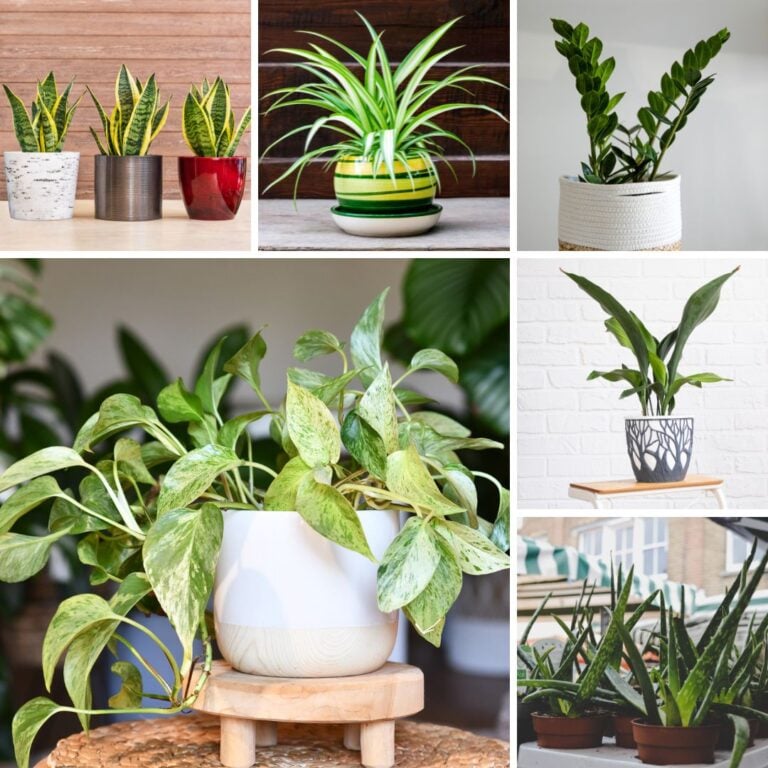Transform Your Space: 20 Best Air-Purifying Plants for You!
Most household materials, including furniture, appliances, and cleaning supplies, emit a wide range of harmful gases in the air.
Some of the most harmful ones include ammonia, benzene, formaldehyde, trichloroethylene, carbon monoxide, and xylene.
These gases must be filtered out of the air, and some indoor plants do this job very efficiently. Research has also found that some plants can absorb these harmful chemicals from the air and help improve air quality and circulation in our homes.
But which indoor plants are the best air purifiers? I researched and picked the 20 best Air Purifying Indoor Plants to improve air quality and make your home aesthetically pleasing.
Please note: Simplify Plants is reader-supported. Some links in the post are affiliate links and I get a commission from purchases made through links in the post.
Barberton Daisy

Barberton daisies have bright-colored flowers, from white to red. They can grow at any time of the year and are efficient cleansers of toxins.
They clean toxins such as formaldehyde and trichloroethylene and purify air to a large extent. These toxins are majorly found in household materials like paints, synthetic cleansers, etc.
Sunlight: Barberton daisies love direct, bright light and will do great near bright window sills. Place them indoors or outdoors in full sun.
Watering: Keep the soil of Barberton daisy evenly moist all the time. Water them when the soil is dry to the touch, ensuring the excess water has drained out.
Fertilizer: Fertilize Barberton daisy every two weeks when flowering. Fertilize with a balanced houseplant fertilizer.
General Care: Barberton daisy-like average to high humidity level around them. Plant them in a well-aerated potting medium. Average temperature levels between 55°F-75°F are ideal for them.
English Ivy
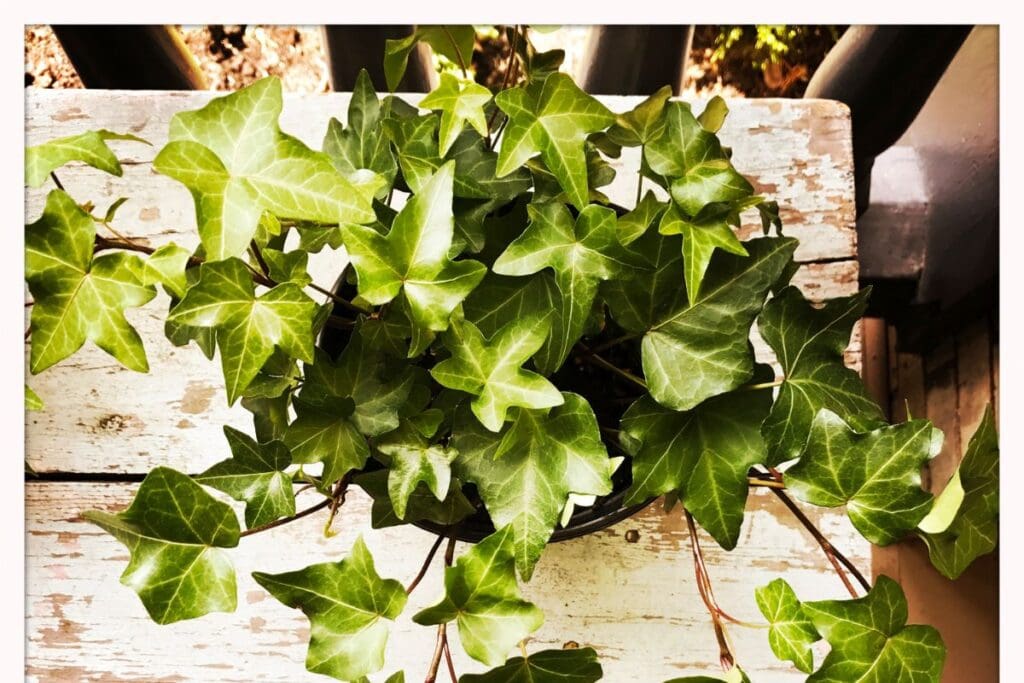
English ivy is a low-maintenance abiding vine with glossy leaves and effectively reduces fecal particles in the air.
They even help combat fungus in the home. They can grow up to 8 feet in height. They are an evergreen foliage plant and dynamic grower. You can keep them in the bathroom, bedroom, or any space you like.
Sunlight: English ivy likes partial to full shade to grow healthy. It also likes indirect bright light all day long and cannot tolerate direct light for long hours.
Watering: English ivy like their soil to be dry between waterings. You can touch or dig your finger in the soil to check soil moisture. If the soil sticks to the finger after you remove it, then the soil is still moist.
Fertilizer: In the growing season, fertilize your English ivy with balanced houseplant food. Dilute the fertilizer to half its strength and avoid fertilizing if the plant is stressed.
General Care: Keep your English ivy at an average temperature and high humidity. They don’t like cold drafts and summer heat, so protect them from such conditions.
Snake Plant

Snake plants are sturdy plants with dignified leaves shooting upwards with twists and stripes.
If you keep them in your bedroom, you will indeed have a calm sleep. The snake plant is one of the most effective plants to filter toxins from the air.
In addition, they release oxygen at night, helping you sleep better.
Sunlight: Snake plants prefer filtered bright light but can also survive in some direct light. They are very forgiving and can forgive some neglect.
Watering: Ideally, you should water your snake plant once a week. The soil should be dry between waterings. You can check the soil by digging your fingers a few inches into it to avoid overwatering it.
Fertilizer: In the growing period, fertilize your snake plant with a mild cactus fertilizer and avoid fertilizing in the dormant period. You can also feed them balanced houseplant food.
General Care: Snake plants thrive in high-temperature levels and may slow growth below 55°F. Keep the plant in a spot to avoid cold drafts and dry air.
Chrysanthemum

Chrysanthemum blooms in various brilliant colors, sizes, and shapes. There are more than 100 species of Chrysanthemum.
These plants also filter a multitude of toxins from the air, including ammonia and benzene. These toxins are primarily found in detergents, paints, plastics, etc.
Sunlight: Chrysanthemum likes indirect bright sun, and some hours of direct sun is also good. They will thrive in the right light and near sunbathed windows.
Watering: Water chrysanthemums to keep the soil evenly moist. Use warm water and water from the base, not the foliage. Reduce watering in the colder months to let the soil stay dry longer.
Fertilizer: Chrysanthemums are heavy feeders during their active growing period. Feed them a balanced, water-soluble fertilizer once a month from spring through summer.
General Care: Chrysanthemums like high temperature and humidity around them.
Spider Plant

Spider plants have beautiful thin leaves with stripes that fall like a fountain. This low-maintenance houseplant is an excellent option for beginners.
NASA highlights them to have air-purifying quality. They work against carbon monoxide, xylene, and many others. They can be kept indoors and outdoors as they adapt to environmental conditions.
Sunlight: Light should be indirect and bright to keep your spider plant healthy and growing more easily. You can keep them outdoors to provide them with enough light in the daylight.
Watering: Water your spider plant moderately to keep the soil evenly moist most of the time. Do not overwater them, but check the soil periodically to prevent it from drying out too much.
Fertilizer: Fertilize your spider plant with a balanced houseplant fertilizer once a month in the growing season. Don’t fertilize them in the dormant period.
General Care: Spider plants like average room temperature and humidity. To promote their growth, they should be repotted once every year.
Aloe Vera
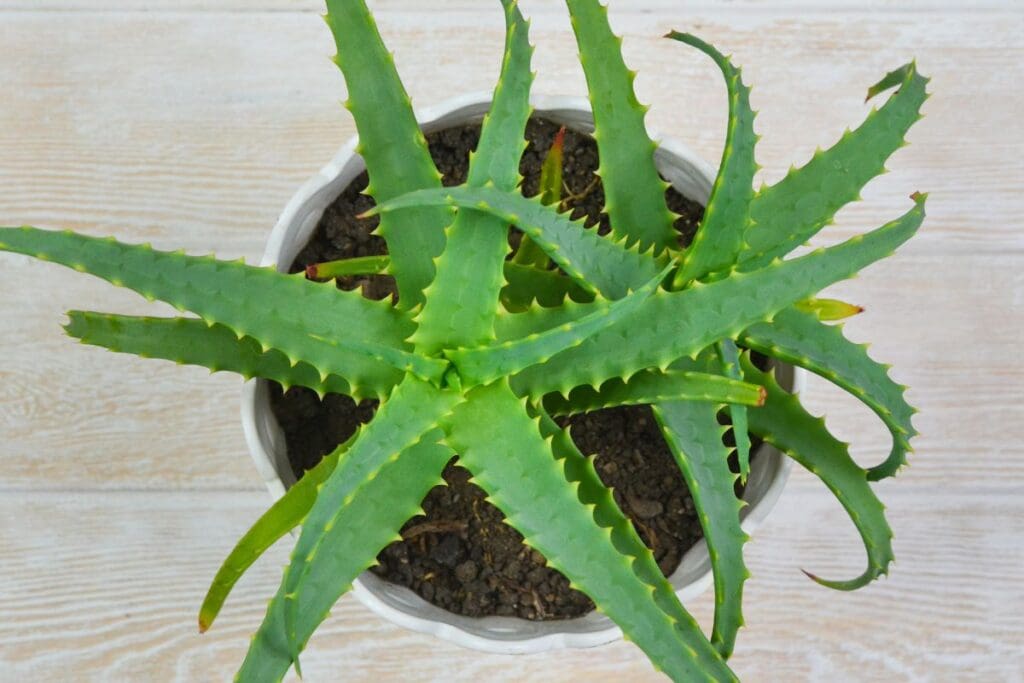
Aloe vera is a must-have charming succulent with healing properties. They can quickly heal sunburns and minor cuts.
These plants can naturally clean air and remove toxins such as formaldehyde from the air. Therefore, they can survive in almost all situations and bloom in unfavorable conditions too.
Sunlight: Aloe vera loves light, but it should be kept in a sunny window where it can get indirect or filtered light. It doesn’t like direct light for too long.
Watering: Aloe Vera should be watered once a week or two, and the soil should be allowed to dry. If overwatered, the aloe vera plant can be affected by root rot and even die.
Fertilizer: Fertilize the aloe vera plant once a month with a portion of balanced food. Dilute the fertilizer to half the strength and feed only in the growing season.
General Care: Aloe vera prefers a temperature level between 55°F-80°F. Please do not keep them out at night during cold weather. Repot aloe vera when they are root-bound.
Broadleaf Lady Palm

Broad Lady Palms are a rare species of fan palms and are pretty pricey to buy entirely grown plants. However, they are easy to grow and are adaptable.
These plants are exceptionally effective at purifying the air. They work well against carbon dioxide, formaldehyde, xylene, and ammonia found in cleaning agents, detergents, varnishes, etc.
Sunlight: Broad lady palm likes full, bright light but prefers filtered light. The leaves will grow deep green if kept in the shade. However, the leaves may turn yellow in full direct light.
Watering: Broadleaf ladypalms should be watered once a week. The soil should not dry completely between waterings. They can tolerate dry periods, but prolonged dry soil can harm the entire plant.
Fertilizer: Broad lady palm can be fed twice in the growing season with balanced houseplant food. Dilute the fertilizer to half the strength.
General Care: Broad lady palm can thrive in a wide range of temperatures from 25°F-100°F. They like moderate humidity, and occasional misting will help in dry weather.
Dragon Tree

The dragon tree, also known as Dracaena marginata, is a houseplant with red-edged foliage, low maintenance, and nearly indestructible.
They are slow-growing plants with tiny white color flowers in the spring. They can fight toxins such as xylene and trichloroethylene and purify the atmosphere, positively filling the space.
Sunlight: Dragon trees like bright light and thrive in partial shade. Keeping them in low light will lead to slow growth and smaller leaves.
Watering: Dragon trees are drought-tolerant, so they can easily survive without water for a specific time limit. Water them in 2-3 weeks, letting the soil dry up to 2-3 inches from the top. Then, water them with distilled water to avoid yellow leaves.
Fertilizer: Dragon trees are a light feeder or may even thrive without fertilizing. If you wish to feed them, then fertilize them with light houseplant food in the early spring. Do not fertilize in winter.
General Care: Dragon tree-like warmer temperatures between 65°F-80°F. They can thrive in household humidity, but if the air is very dry, then occasional misting will help.
Weeping Fig

The weeping fig is a beautiful plant with slim branches and dark, glossy green foliage. They can grow up to 6 feet tall indoors.
They are vigorous growers and need plenty of food. They are considered one of the best plants to improve air quality by removing toxins like formaldehyde, benzene, and trichloroethylene.
Sunlight: Weeping figs like a bright light that is filtered and some direct light in the morning. Find a bright spot for them, and don’t move them in different light conditions too fast.
Watering: keep your weeping fig’s soil evenly moist, but do not keep the soil in standing water. The leaves drop due to soggy soil and root rot. Check the soil before watering them.
Fertilizer: Fertilize your weeping fig throughout the growing season with balanced houseplant food. Fertilize by diluting the food into half the strength and feed every month to promote their growth.
General Care: Weeping fig prefers moderate to high temperature around them. You can set up a regular thermostat to regulate temperature shifts.
They may suffer in temperatures below 65°F. Keep them away from air conditioners and heating systems. Keep high humidity around weeping figs and mist occasionally on the leaves.
Chinese Evergreen
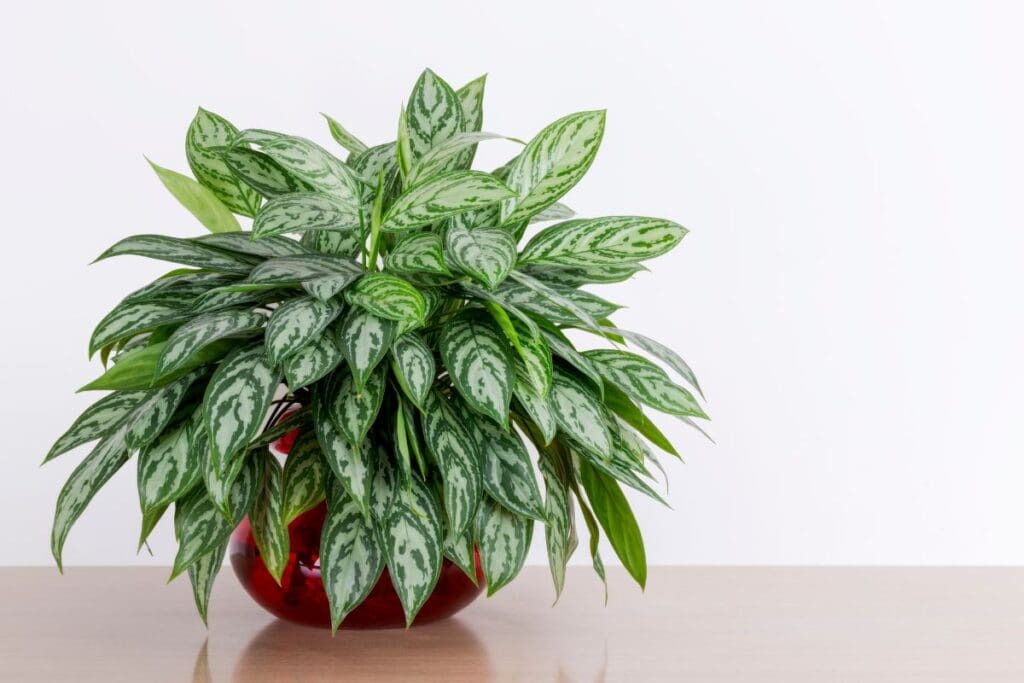
Chinese evergreen is a classic plant with glossy oval-shaped foliage on short stems and blossoms in the growing season.
They are slow-growing, adaptable plants and can be grown all year round. Along with adding beauty to space, they also clean the toxins from the air, which are found in detergents, cleansers, and cosmetics.
Sunlight: Chinese evergreen can grow in shaded areas, low light to bright light. The variegated varieties need bright, indirect light throughout the day to maintain their variegation.
Watering: Chinese evergreens like their soil to be evenly moist and should not be kept soggy. Water them and let the soil dry before the next watering, but not completely dry.
Fertilizer: You can fertilize Chinese evergreen with balanced houseplant food. Fertilize them once in the early spring and at the end of the summer to promote their growth.
General Care: Chinese evergreen plants thrive in temperatures above 65°F and can suffer in low-temperature levels. They thrive in high humidity. Keep them in a warmer spot in cooler temperatures away from vents and heating systems.
Pothos

Pothos is one of the easiest plants to grow and best for beginners. They have heart-shaped foliage that is variegated in white, yellow, or pale green.
They grow about 1 foot per month if taken care of properly. They are flexible, forgiving, and clean air, making the air pure and breathable.
Sunlight: Pothos like bright but indirect light, especially the variegation, needs light to maintain variegation. Direct light can burn the leaves.
Watering: Pothos like their soil to dry out completely between watering. If the soil is kept continuously moist, the plant can suffer from root rot. Water when the leaves droop, indicating that they need water.
Fertilizer: Pothos are light feeders. Feed them with light fertilizer in the growing season. Dilute the fertilizer and feed in the early spring and end of the growing season.
General Care: Keep your pothos in temperature above 50°F, and best thrive in medium temperatures. They like high humidity, and you can mist to help increase the moisture in the air.
Kentia Palm

Kentia palm is a stylish, eye-catching houseplant that gives a forestry look to space with its arched leaves.
They are resilient, easy to grow, and purify the air. These plants are adaptable to a wide variety of conditions without complaint.
Sunlight: Kentia palm thrives in low to bright light. They grow best in low light. Direct sun can harm the leaves and the plant in the long run.
Watering: Kentia palm likes their soil to dry out between watering. They don’t like their soil to sit in water. Watering once a week during summer is good enough; during winter, slow down your watering schedule.
Fertilizer: Fertilize kentia palm throughout the growing season with liquid fertilizer or slow-release fertilizer. You can use a specially formulated palm fertilizer found in the market.
General Care: Kentia palm prefers warmer temperatures and high humidity. They can even survive at a temperature level below 25°F. You can mist around them to add some humidity to the air.
Rubber Plant
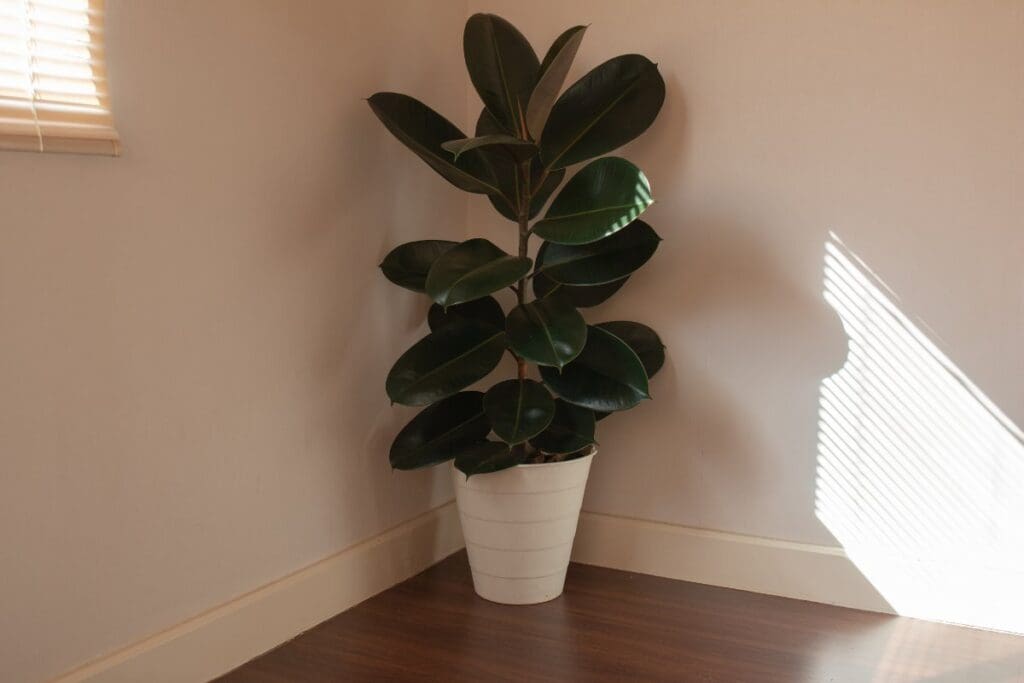
The rubber plant is a beautiful houseplant with rubbery, glossy, dark green foliage. They are low-maintenance, adaptable plants and thrive if taken care of properly.
Along with cheering your living room, and bedroom, they also clean toxins from the air. They clean the air and increase the humidity of the space too.
Sunlight: Rubber plants like a lot of light that is indirect. Keeping them in a sunny spot by filtering the light with a sheer curtain will reduce the intensity of intense light. However, low light in the long term can lead to leggy rubber plants and dull leaves.
Watering: Rubber water likes its soil to stay moist during warmer months and dry in cooler months. Always check the soil’s moistness before watering it.
Fertilizer: Like most houseplants, fertilize rubber plants with houseplant food in a balanced ratio. Fertilizing is required in the growing season only.
General Care: Plant your rubber plant in a well-draining soil mix, and check your drainage system. Maintain high humidity and high temperature around them.
Boston Fern

Boston fern is a species of fern, a very traditional houseplant with sword-shaped evergreen leaves. They grow slowly and are easy to grow houseplants.
These plants help improve air circulation in the room and clean the toxins from the air. They are very popular among beginners and enthusiasts.
Sunlight: Boston fern likes bright filtered light to grow healthy green fronds. Low light will give you sparse fronds, and direct sun can cause sunburn to the fronds.
Watering: Boston fern likes its soil to be evenly moist in warmer months. Water them when the top of the soil is dry to the touch.
Keeping the soil dry can lead to the falling of the fronds. Therefore, reduce watering frequency during winter and fall and only water them when the soil dries out.
Fertilizer: Feed your Boston fern with a liquid fertilizer throughout the growing season, once every month. Avoid fertilizing during the dormant period.
General Care: Plant Boston fern in a rich potting soil medium with good drainage. They thrive in temperatures between 65°F-85°F. They prefer a humidity level above 80%, which you can maintain by using a humidifier.
The Flamingo Lily

The Flamingo lily(Anthurium andraeanum) produces lustrous heart-shaped leaves. They are complemented by bright, slick, red heart-shaped blooms with yellow spadices, which last for 2-3 months on average. They absorb airborne chemicals present in chemical cleaning products.
Sunlight: The flamingo lily thrives in medium to bright light but never direct light. They need bright light 6-8 hours daily to produce blooms and improve growth.
Watering: The flamingo lily likes its soil to dry out between watering. Water it with filtered water or rainwater when they are partially dry.
Fertilizer: Fertilize the flamingo lily with a slow-release fertilizer once a month in the growing season. Fertilize 25% of the recommended dosage in the package.
General Care: Maintain high humidity and high temperature around your flamingo lily. Clean the leaves with a damp cloth to help them stay dust-free and healthy.
Kimberly Queen Fern

Kimberly queen fern is a fast-growing houseplant with gracefully curving fronds. They can grow up to 3 feet tall indoors.
They are low maintenance and considered an effective plant in purifying the air. They clear toxins like formaldehyde and benzene found in chemical cleaners.
Sunlight: Kimberly Queen Fern prefers low light to bright indirect light. Keep them near a bright window and avoid harsh direct sun. Direct sun can burn the fronds.
Watering: To keep your Kimberly queen fern thriving, water them when the top of the soil is dry to the touch. Keep the soil evenly moist and never soggy.
Fertilizer: Fertilize Kimberly queen fern with a balanced diluted fertilizer from spring through summer. Avoid fertilizing in the dormant period.
General Care: Maintain temperature level between 55°F-75°F. They cannot tolerate frost. Take extra care during cooler months. Don’t keep them near cold windows and heating systems.
Dracaena Fragrans
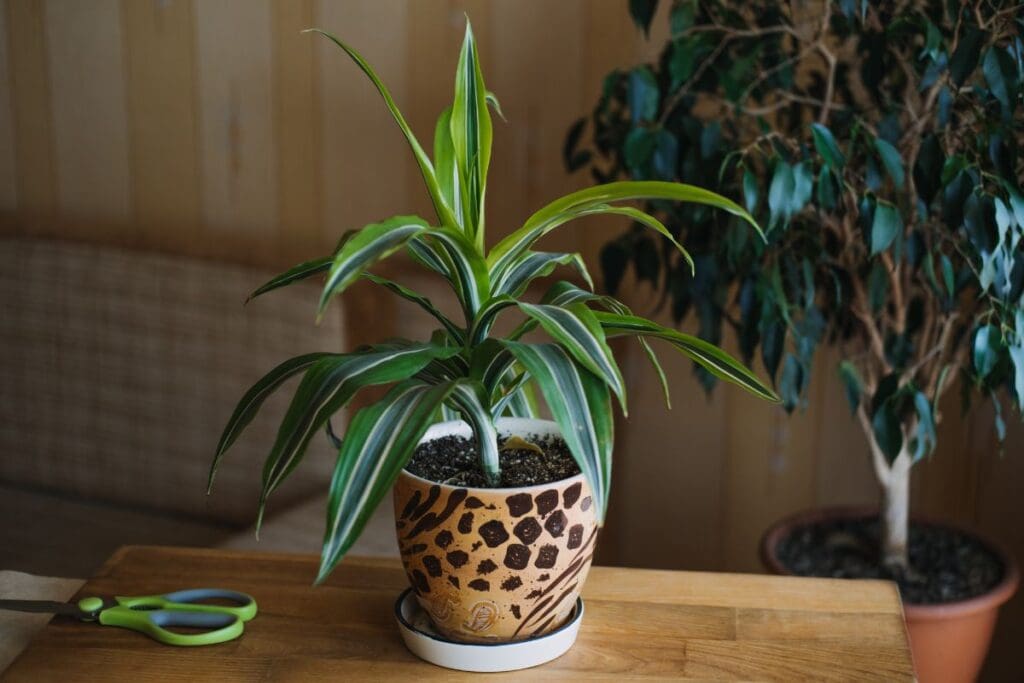
Dracaena Fragrans is an exquisite houseplant reaching up to three feet indoors, looking like a tree, giving a forestry look to space.
The dramatic foliage has colorful patterns and, along with beauty, dracaena also has air-purifying quality. They are visually striking, primarily due to their green leaves with yellow stripes.
Sunlight: Keep your Dracaena Fragrans near a sunny window shielded by a sheer curtain. They like bright indirect light or semi-shaded light. Avoid direct sun.
Watering: Water your Dracaena Fragrans when the soil is dry up to 2 inches from the top. Keep the soil lightly moist, and never keep the soil sitting in water. This can attract root rot and other issues.
Fertilizer: Fertilize your Dracaena Fragrans with water-soluble houseplant food at half the recommended strength. Feed them during the growing season and avoid feeding in a dormant period.
General Care: Maintain temperature level between 65°F-80°F for Dracaena Fragrans. Keep them away from cold drafts and heating appliances. They prefer high humidity.
Peace Lily

The peace lily is a forest green plant with delicate white flowers. They come in a wide variety and reach up to 3 feet tall. They are on the list of top ten household air-cleaning plants by NASA.
This resilient, forgiving plant helps cleanse the air we breathe. They effectively remove all indoor pollutants from furniture, electronics, and cleaning products.
Sunlight: Peace lily prefers partial shade and even survives in a room without a window. Give them indirect light and never direct light, as it can scorch their leaves.
Watering: Water your peace lily once a week in summer and slow down watering in winter. Keep the soil slightly moist between watering. They droop a little when thirsty so that you can take it as a signal for watering.
Fertilizer: Feed peace lily once in spring and once in summer with a houseplant fertilizer. Dilute it to half the strength and avoid feeding in winter and fall.
General Care: Peace lily flourishes in the indoor temperature in which we live and enjoy. Please don’t keep them in temperatures below 45°F and cold drafts.
Scarlet Star Bromeliad

Scarlet star bromeliad is a beautiful and versatile houseplant that adds beauty and color with its leathery leaves and bright red-colored bracts.
The flower looks like a star from the top and will take two to three years to form. However, they are effective air cleansers and make the air breathable.
Sunlight: Keep your scarlet star bromeliad in a spot where it can get bright filtered light all year round. They can grow well in fluorescent light, too but avoid direct light.
Watering: Water your scarlet star bromeliad every few days in summer, keeping the soil dry between watering. Do not over-water them; check the soil moistness before watering them, irrespective of the season.
Fertilizer: Feeding scarlet star bromeliad monthly with liquid houseplant food. Dilute the fertilizer at half the strength to promote their growth.
General Care: Scarlet star bromeliad likes temperatures ranging between 65°F-90°F. They like humid air to grow properly and dislike cold and hot drafts.
Areca Palm

Areca palms are attractive palms with smooth and sometimes golden trunks. Their leaves look like bamboo leaves that are narrow and whole.
They have a moderate growth rate and are easy to care for. In addition, these plants can clean toxins such as formaldehyde, benzene, xylene, and toluene from the air.
They are efficient humidifiers as they clean toxins and lower humidity levels inside.
Sunlight: Areca palm prefers bright indirect light, and the best part is they can even tolerate full sun. Aim to give them more indirect light than direct light.
Watering: Areca palm likes their soil to stay moist but never soggy. Let the soil dry out slightly before watering them every time. It’s better to use distilled or fluoride-free water for your areca palm.
Fertilizer: Areca palm is a heavy feeder and should be fed throughout the growing season. Fertilize them once every month by diluting the strength to half. Do not fertilize in winter and fall.
General Care: Areca palm thrives in temperature levels between 65°F-75°F. Keep them away from cold windows, air conditioners, and heat sources. High humidity will help Areca palm thrive.

Source: NASA Clean The Air Study, Wikipedia Air Purifying Plant.
Recommended Garden Supplies
| Product Image | Our Recommended Gardening Supplies | Check Offers! |
|---|---|---|
Top Top
Top
Top
Top
Top
Top
Top
Top | rePotme Houseplant and Tropical Classic Potting Soil Mix | Check Offer On Amazon |
 Top
Top
Top
Top
Top
Top
Top
Top | Espoma Organic Indoor Plant Food | Check Offer On Amazon |
 Top
Top
Top
Top
Top
Top
Top
Top | GooingTop LED Grow Light 6000K Full Spectrum Clip Plant Growing Lamp | Check Offer On Amazon |
 Top
Top
Top
Top
Top
Top
Top
Top | Soil Moisture Meter | Check Offer On Amazon |
 Top
Top
Top
Top
Top
Top
Top
Top | Govee Hygrometer Thermometer, Bluetooth Enabled! | Check Offer On Amazon |
 Top
Top | LEVOIT Humidifiers for Large Room(Best For Plants) | Check Offer On Amazon |
 Top
Top
Top
Top
Top
Top
Top
Top | Upgraded DIY Automatic Drip Irrigation Kit, 15 Potted Houseplants Support | Check Offer On Amazon |
 Top
Top
Top
Top
Top
Top
Top
Top | Stainless Steel Heavy Duty Gardening Tool Set | Check Offer On Amazon |
 Top
Top
Top
Top
Top
Top
Top
Top | Bonide Insecticidal Soap | Check Offer On Amazon |
 Top
Top
Top
Top
Top
Top
Top
Top | Bonide 32 oz Spray Neem Oil for Organic Gardening | Check Offer On Amazon |
 Top
Top
Top
Top
Top
Top
Top
Top | Garden Safe Fungicide | Check Offer On Amazon |





